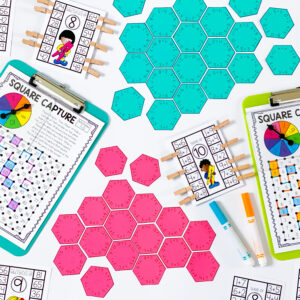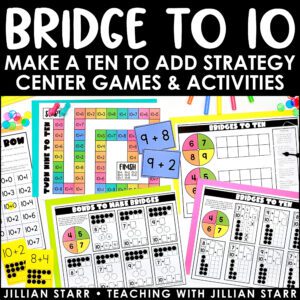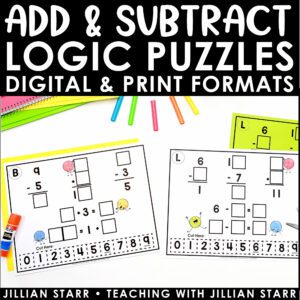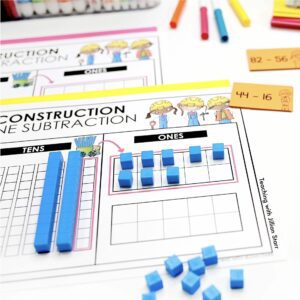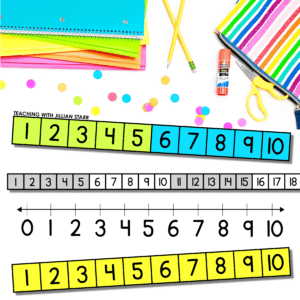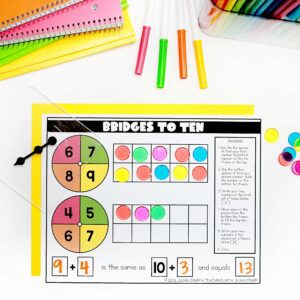
When I say “ways to make ten,” I mean that young mathematicians need to be able to fluently recall addends that equal ten. Not just any two addends either, they need to be able to name all of them!
When we think about working with students on addition, subtraction, place value, and missing addends, ALL of these skills are supported by fluency with ten. If students do not have a solid foundation of fluency with ten, working within these concepts will become more and more frustrating over time.
So, today, let’s dig deeper into why we really need to get kids fluent with ways to make ten, how it sets them up for math success later on, and some of my favorite ways to help kids nail it.
Why Ways to Make Ten?
To quote toddlers everywhere, “Why?” Well, ten is the basis of our place value system. Because ten and multiples of ten are such important benchmark numbers, young mathematicians need to be able to flexibly and efficiently know the ways to make ten.
Being able to make ten efficiently is a skill that gets built upon over and over as kids move through the primary grades and beyond. In first grade, students work on adding and subtracting within 20 and adding 100.
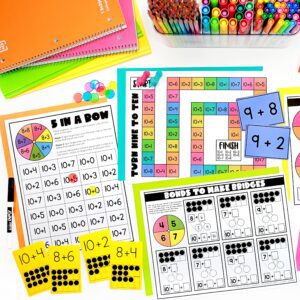
Make A Ten To Add Activities
What It Looks Like to Make Ten in First Grade
Let’s take 7 + 4 for example. Kids often struggle with problems that have sums above 10 because, well, they run out of fingers. However, if students fluently know that 7 + 3 = 10, they can easily use that fact to solve 7 + 4. They can either know that 4 is 1 more than 3, so 7 + 4 must be 11.
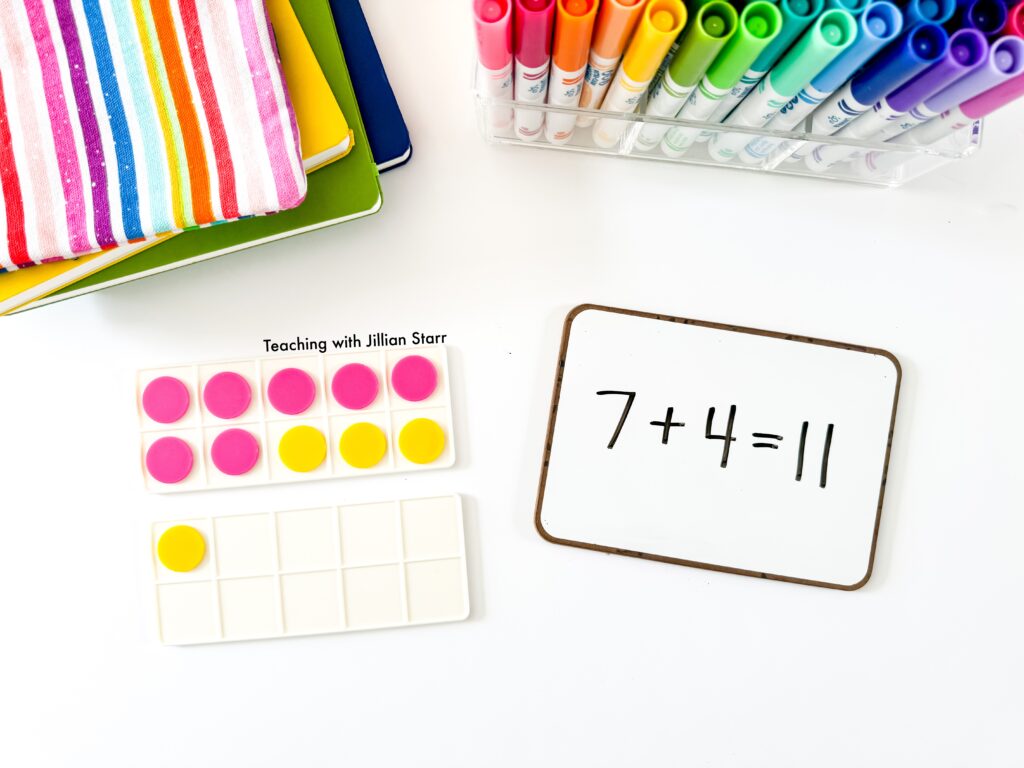
On the other hand, they can use the “make a ten” or “bridge ten” strategy to add by decomposing 4 into 3 and 1 and solving 7 + 3 + 1.
Kids can use a similar strategy when solving those bigger problems within 100, too. Let’s expand on our first example and say a student is solving 77 + 14. They know that they need to combine the tens and combine the ones to find the sum but that is hard work for our first graders! Making ten can make this all much easier.
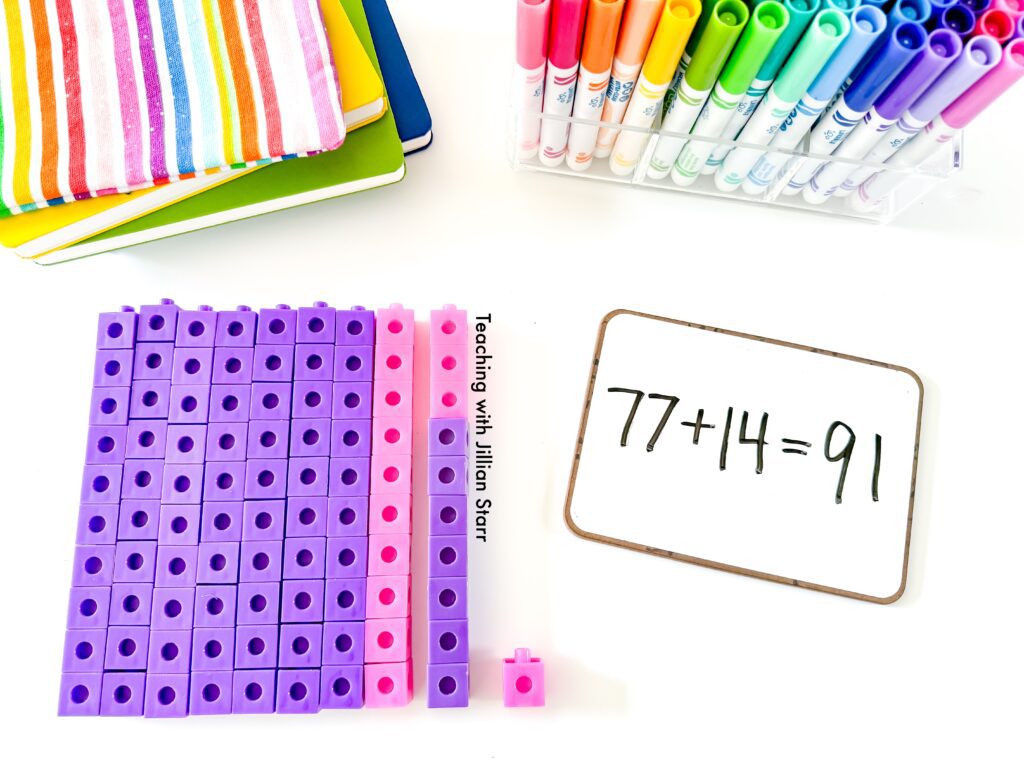
In this case, it’s not exactly making ten but making a ten, a multiple of ten. If kids fluently know 7 + 3 = 10, they can use that knowledge to solve 77 + 3 = 80. Since they decomposed the 14 into 3 and some more, they still have 11 left. 80 + 11 = 91 so 77 + 14 = 91. Making a ten for the win!
Making Ten Beyond Grade One
Let’s build on that some more. In second and third grades, kids dig even deeper into using place value strategies to add and subtract within 1,000 and beyond. Fluently knowing ways to make ten is critical at this stage, because this is when students begin to dig into regrouping (carrying and borrowing, if we’re talkin’ old school). Regrouping is simply making groups of ten in multi-digit calculations.
Let’s take 456 + 68 as an example. There are a variety of ways to use place value to approach that problem: using base ten blocks, drawing base ten blocks, using expanded form, using an open number line, and of course, the standard algorithm. Making a ten is key in all of those! Because 6 + 8 is greater than 10, students need to recognize that and then be able to figure out how many more than 10 it is to regroup accurately.
Even when using an open number line, adding to create a multiple of ten makes the addition much easier. Take a look at this number line:
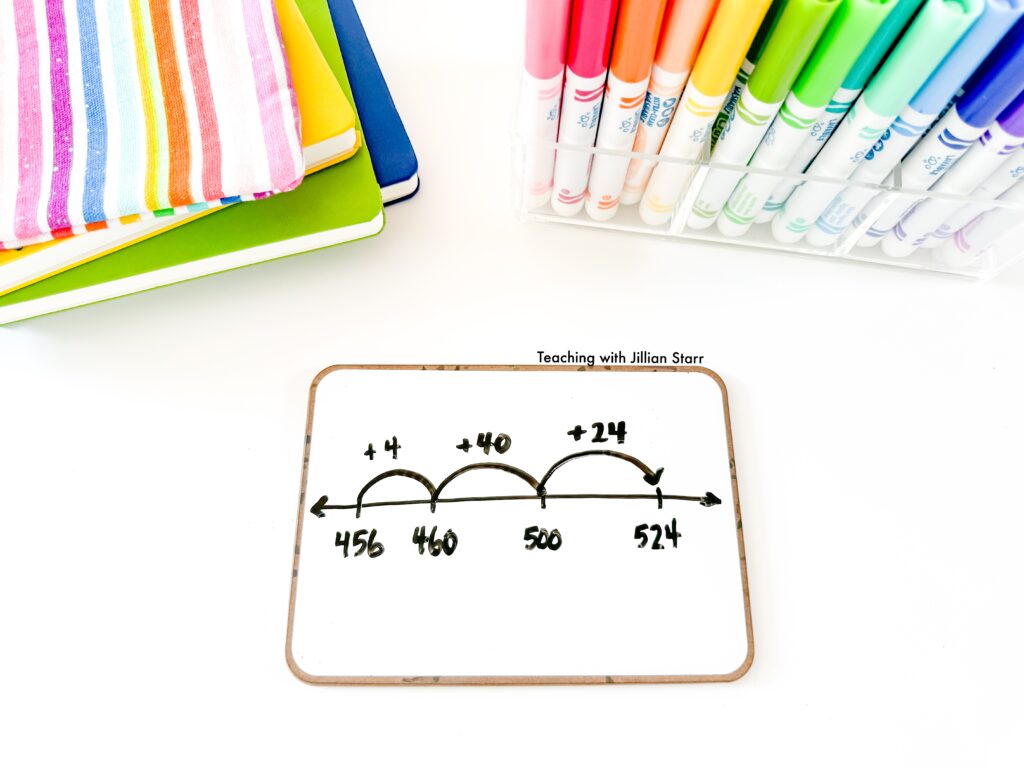
Starting at 456, this student immediately added 4 to make 460, a much easier number to wrangle. Then they knew that they still had to add 64, but 460 + 64 is not super straightforward. So they decomposed the 64 as 40 and 24. Why 40? Because they knew that 60 + 40 = 100! How did they know that? Because they knew that 6 + 4 = 10! Can you imagine how much harder that would have been if they didn’t fluently know 6 + 4 = 10?? Once they recognized that, they easily solved 460 + 40 = 500 and 500 + 24 = 524.
I could go on and on, but I’ll just say that being able to fluently make ten and being able to use that to solve problems, really builds students’ number sense, unlocking a whole world of strategies for tackling problems with that magical number ten.
Activities for Teaching Pairs of Ten
Now that we’ve covered the why behind the magic of fluency within ten, let’s take a look at how you can start this work in your classroom right now. Keep reading on for some of my favorite activities to make ten!
Ten Frames to Make Ten
Use ten frames everywhere! This is less of an activity and more of a general suggestion because the more students internalize what numbers 0 – 10 look like on ten frames, the more likely they are to be able to visualize how many more they would need to make ten.

It helps to provide students with a ten-frame or double ten-frame anytime they are counting objects or solving addition or subtraction problems. Reinforcing the concept of ten, what it looks like, how many are missing from ten, etc. will help build fluency with these math facts. Of course, some kids won’t “need” the ten frames to solve the problems, but give them to those kids anyway! They can use them or not, but having them available to all students regardless, reinforces the importance of the tool and the importance of 10 as a benchmark number.
Use of Fingers to Make Ten
Does that recommendation come as a surprise? It definitely surprises some of my students when I tell them to use their fingers, but they are amazing tools that are always available! They are like a ten-frame that we carry with us everywhere. Ok, not quite, but stay with me, I have a fun game idea for you.
I call this game How Many More to Make Ten? I have played this game with my kids anytime we’ve had spare time – stopped at a red light, waiting at the doctor’s office, or at the dinner table. The only materials you need are your hands. Here’s how to play: Hold up a number of fingers from 0 – 10 and ask, “How many more to make ten?” Yup, that’s it!
Kids can then figure out how many more to make ten in a bunch of ways. They might just automatically know. They could also represent the number on their own fingers and then use their own fingers to see how many more they’d have to put up to show ten. They could also use their hands and look at how many fingers are down to solve it. Regardless, they are doing some important work: practicing pairs of numbers that equal ten, and (bonus!) they are working on subitizing.
Cuisenaire Rods to Make Ten
In my opinion, Cuisenaire rods are underrated, especially when it comes to math facts. Cuisenaire rods are pieces of wood or plastic that are uniformly sized and colored. A white piece is always 1. The red piece is the size of two white pieces, so it is 2. The blocks continue until we get to the orange rod which is 10.

How do I like to use these to work on ways to make 10? We focus on that ten rod! I will have students place the orange ten rod at the top and then use two rods to find all the ways to make a “train” that is the same size as the orange rod.
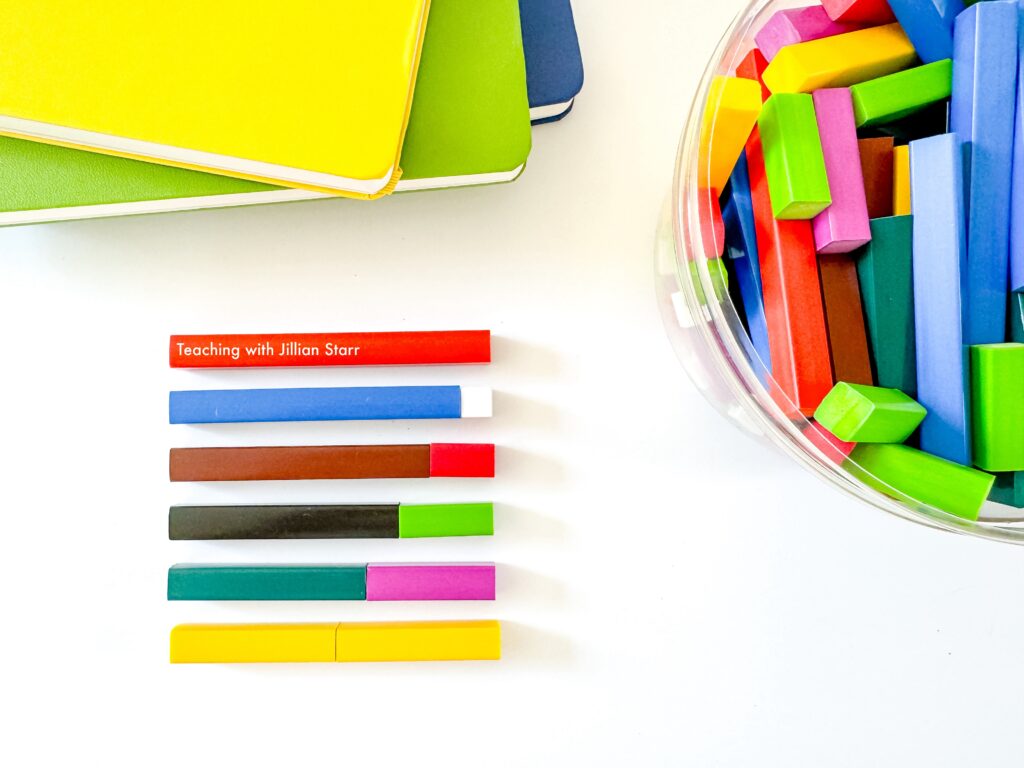
Once students have built all the ways they can to make ten, we’ll write addition equations to match them. From here, we can use the rods in other ways to practice. I can show them one of the rods and ask them what rod they need to make ten – it’s a more abstract version of the finger game! We can also turn them around and solve subtraction problems starting with 10. As students master this work, they will begin to internalize the pairs of numbers that add to ten and are ready to work on automaticity which leads us to…
Card Games to Make Ten
I did say that these games are good for automaticity with pairs of numbers that add to ten, but they can also be played before then. Just be sure to provide kids with ten frames or Cuisenaire rods or encourage them to use their fingers! You can even use the ten-frame playing cards below!
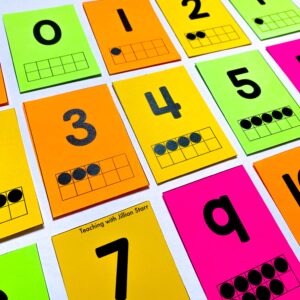
Free 10 Frame Playing Cards
Upgrade the playing cards in your classroom to include ten frames! This will immediately help reinforce skills like composing and decomposing ten, as well as subitizing with ten fames! WIN/WIN!
10s Go Fish
This is a take on the classic game, Go Fish. The difference here though is that players are not looking for cards that match, but instead cards that add to 10. When playing this with a regular deck of cards, I have kids use Aces as 1s and Jacks as 0s and remove the other face cards. This way, all of the number cards will have a match. From there, you can play whatever “house rules” work best for you! Do you get to go again if you make a match? Do you start with 5 or 7 cards?
Pairs of 10
There are lots of ways to play, but here’s how I like to play. Again, I use Aces as 1s, Jacks as 0s, and remove the other face cards. Then my partner and I turn over ten cards from the deck and place them in two rows of five (like a ten frame!). The rest of the cards stay in a pile face down next to them.
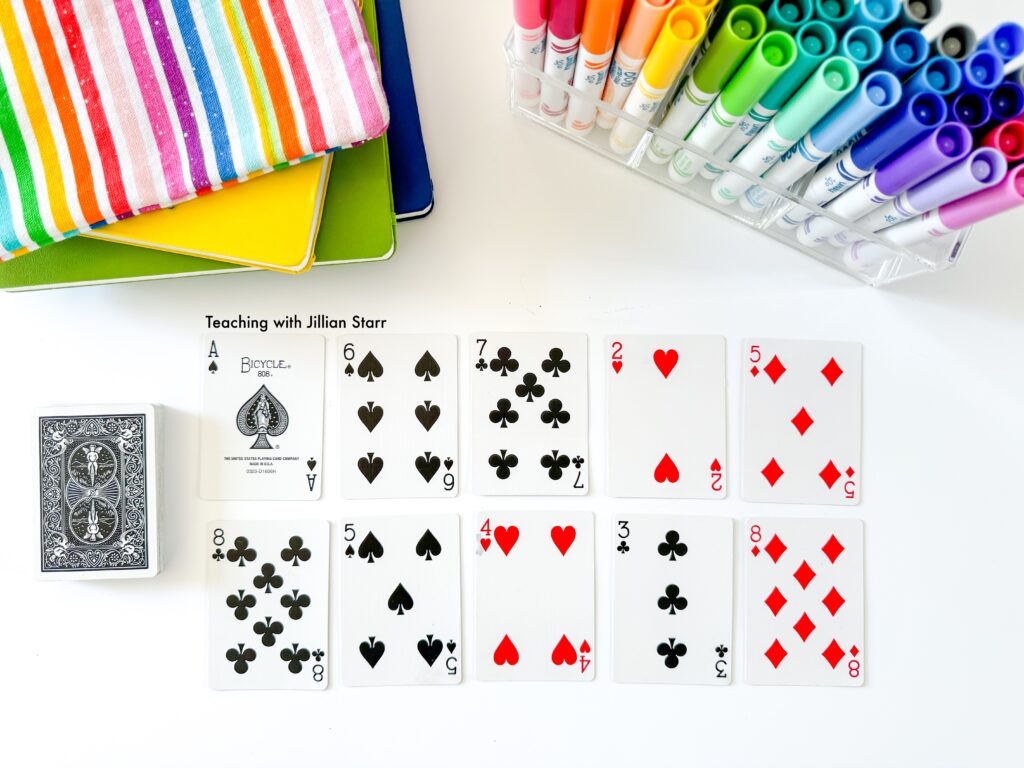

Once we’re set up, we take turns looking at the face up cards to find cards that add to ten. If it was my turn, I could match the 2 and 8 and the Ace and 9, leaving four empty spots in our game. We would then replace those four cards with new cards from our draw pile and my partner would take their turn. When the whole deck has all been used, the game is over! If you’re playing the win/lose version, the player with the most cards at the end is the winner.
So there you have it – why we want students to fluently know all the ways to make ten! Let’s get those kids seeing and making ten everywhere!

